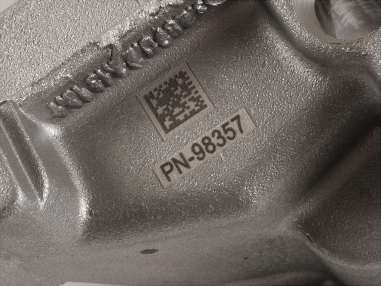Direct Part Marking: An Evolving Bar Code Technology for Automated Traceability
 With the current popularity of the two-dimensional bar code, many people see QR codes as more temporary applications often printed on labels or paper. But those in the aerospace and auto industries know that 2D bar codes have been used for over twenty years to permanently mark parts that may have a life of three decades or more.
With the current popularity of the two-dimensional bar code, many people see QR codes as more temporary applications often printed on labels or paper. But those in the aerospace and auto industries know that 2D bar codes have been used for over twenty years to permanently mark parts that may have a life of three decades or more.
Known as direct part marking (DPM), 2D bar codes such as QR code and DataMatrix can be etched into a part and used as an identifier as long as that piece is in service. And DPM can greatly enhance traceability, providing automatic tracking throughout an entire life cycle.
(Image: Laser sample mark with 2D bar code on raw metal. Image provided by Automatic Identification Systems, Inc.)
The Evolution of Direct Part Marks
Also called machine readable identification, direct part marking was adopted by NASA in the late 1980's, after determining that the optimal way of identifying and tracing a part was via a symbol marked directly on it. During the process, NASA proved that these symbols can be applied to most aerospace materials without affecting performance. Standards for the automotive, pharmaceutical, aircraft, and electronic industries soon followed.
The most widely used symbology for direct part marking is the DataMatrix 2D bar code. NASA adopted the bar code after five years of testing, and the Department of Defense in the United States selected DataMatrix for use in identifying assets in the various military services. It is also used by Motorola.
Automobile manufacturers often use the QR code for direct part marking, as it was developed in the 1990's by Toyota subsidiary Denso Wave for use in the manufacturing process in Japan.
Technologies Used to Imprint Direct Part Marks
Currently, the three most effective technologies for printing DPM on a variety of surfaces are lasers, dot peening, and ink-jet printing.
(1) Laser imprinting offers good contrast between the modules in the pattern and the best resolution of the technologies, but causes the most surface damage to the part. The laser beam converts light energy into heat energy when it hits the surface of the part, creating a mark via melting, ablation, or chemical reaction.
(2) Dot peening is an impact marking process using an electrical or pneumatic driver. A stylus point hits the part like a ball peen hammer, leaving a small dimple. The process offers good resolution and less surface damage than a laser, and is also less costly.
(3) Ink-jet printing forces ink drops to the surface of the part. Once the fluid evaporates, the residual color is left. Not considered a permanent mark, ink marks most effectively on surfaces such as plastic and glass.
Advantages and Disadvantages of Direct Part Marking
Two of the more common strategies used as alternatives to DPM are simple labeling and radio frequency identification (RFID) tags. DPM gets high grades as the most permanent technology as long as the mark has been applied correctly. It is also more visible than an RFID tag, but requires a greater capital investment. A basic label will certainly be the simplest to apply, but carries virtually no degree of traceability.
More and more industries searching for automated traceability for longer and longer life cycles are turning to a form of direct part marking with high degrees of success.
See these related articles:
Applications For QR Code Etching and Engraving
Speed, Functionality and Expanded Usage Push 2D Imagers Ahead of Laser Scanners
Also - you may wish to explore these documents:
ISO/IEC TR 29158:2011 (Ed. 1) Information technology -- Automatic identification and data capture techniques -- Direct Part Mark (DPM) Quality Guideline
ISO/IEC TR 24720:2008 (Ed. 1) Information technology -- Automatic identification and data capture techniques -- Guidelines for direct part marking (DPM)
{jcomments on}
